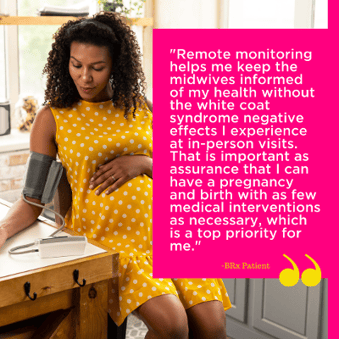Remote patient monitoring (RPM) is increasingly becoming an imperative for health systems, with unexpected benefits.
RPM was growing in popularity long before Covid. It was being used to supplement a strained physician workforce, provide a more continuous connection between providers and patients, and respond to the increased consumer demand for convenient healthcare solutions.
 When the pandemic hit, RPM became a necessity for those who had the infrastructure to deploy it. As safety concerns and social distancing restrictions complicated access to in-person care, RPM was used to fill the gaps, keeping patients safe at home without compromising their care.
When the pandemic hit, RPM became a necessity for those who had the infrastructure to deploy it. As safety concerns and social distancing restrictions complicated access to in-person care, RPM was used to fill the gaps, keeping patients safe at home without compromising their care.
Now with the increased use of RPM, health systems are discovering another benefit — the ability of remote monitoring to accurately capture blood pressure readings compromised by white coat syndrome, and identify and manage potential adverse health outcomes.
“White coat syndrome” or “white coat hypertension” (WCH) refers to the sudden rise in blood pressure that occurs when someone goes to the doctor’s office, as a direct result of the anxiety that they feel about their situation.
 Remote monitoring of blood pressure is strongly recommended for these patients, in part for the obvious reason that an at-home reading will be more accurate than an in-office reading — patients who suffer from WCH are hypertensive during office visits but otherwise normotensive.
Remote monitoring of blood pressure is strongly recommended for these patients, in part for the obvious reason that an at-home reading will be more accurate than an in-office reading — patients who suffer from WCH are hypertensive during office visits but otherwise normotensive.
But the benefits of remote BP monitoring for WCH go beyond a simple matter of accuracy. Patients who suffer with the syndrome are likely to have similar elevated blood pressures in other stressful situations — these critical events are not limited to their time in the doctor’s office. A spike in BP at the doctor’s office is likely an indication of a bigger problem.
According to a report from the New England Journal of Medicine, the risk of death from cardiovascular complications is nearly twice as high for patients with untreated WCH, compared to those whose BP is normal when taken at the doctor’s office.
For pregnant women, for whom hypertension is one of the leading causes of mortality and morbidity, remote BP monitoring is essential. Pregnant women with WCH are at increased risk of developing preeclampsia and gestational hypertension.
 Yet treating these patients with medication is not often a viable solution, as their elevated BP events are isolated. Medication can lower their otherwise normal blood pressure to dangerous levels.
Yet treating these patients with medication is not often a viable solution, as their elevated BP events are isolated. Medication can lower their otherwise normal blood pressure to dangerous levels.
Enter RPM. Out-of-office BP monitoring is critical in the diagnosis and management of hypertension for those suffering with WCH. It’s been proven to be a stronger predictor of cardiovascular deaths than doctor’s office readings; and for pregnant patients, it’s been instrumental in identifying and managing preeclampsia, gestational and postpartum hypertension.
RPM is a critical step on the pathway to better outcomes for hypertension, and addressing white coat syndrome is a significant part of that.
For more on the benefits of remote BP monitoring in pregnancy, check out these recent Babyscripts patient stories:

Submit a comment